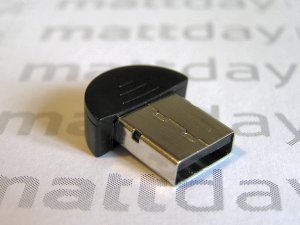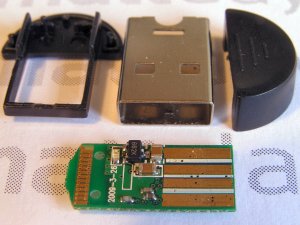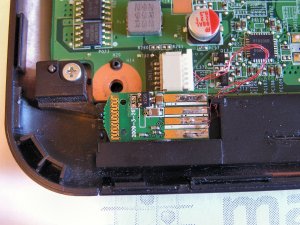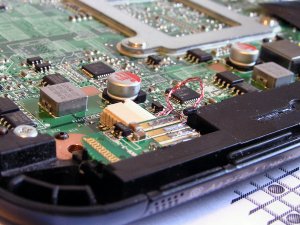Low Cost Bluetooth for Mini 311
Like most 311s, mine came with a mini PCI-E wifi card with integrated bluetooth (BCM4312). For various reasons I chose to replace this with a different card, and at the time, there were no other wifi options with bluetooth (i.e. no other half-height mini PCI-E cards known to work with the 311 under all OSs). HP's solution for this is a separate internal bluetooth module which connects via a cable at the front of the motherboard. The module and cable are parts 537921-001 and 584687-001 and can be bought from HP, but together become rather pricey. I suspected communication with the module was via USB, allowing a cheaper alternative. It turned out I was correct.
 | The picture left shows a typical 'micro' USB bluetooth module bought on eBay. This one cost £1.70 delivered. Obviously, you could just plug this into one of the USB ports to solve your bluetooth problem. The downside is you lose a port and gain a bulge. I will describe how to use the module internally in place of the HP part. |
 | The dongle pops apart easily allowing removal of the circuit board. Despite the opaque plastic case of this dongle, I noticed a LED on the board (the white rectangle at the top left). I removed this to save a tiny amount of power, and checked the dongle still worked. |
 | The picture left shows the other side of the board. The wiggly trace visible from both sides is the antenna. |
The internal module connects via a 6-way JST SH connector (1mm pitch, crimp style). Only four of the pins are used for the USB interface. There are two important points to note. The connector supplies 3.3V VCC instead of the usual 5V. So don't expect any USB device to work (although the pictured bluetooth dongle does). Secondly, when wireless is disabled, power is switched off to this port.

The picture above gives the pin-out for the internal connector, showing exactly how bluetooth is wired up. The contacts in the 6-way connector are pretty small, but on the dongle, the USB contacts provide nice big solder pads.
I checked the power used by the dongle (before the LED had been removed) to make sure it was not going to have any noticeable effect on battery life. At idle it used about 13mA at 3.3V, i.e. 43mW. This went up to about 41mA when scanning for devices. The circuit board from this bluetooth dongle, although small, is not quite as thin as the HP part. I investigated a number of positions for the module, before deciding it should go in the same position as the HP part. The simple reason for this is due to a gap in the shielding created specifically for a bluetooth module. Anywhere else and a weak signal is likely to result. I removed the plastic ridge from the speaker assembly to allow it to fit in this spot. Below are a couple of pictures of the board fixed in position with some hot-melt glue.
Enjoy hacking your 311s! |



help
hey,thanks for ur post......i have a question.what are d+ and d-......are they receiver and transmitter??? can i connect it with any arduino board.......??
u can email me with answer.....at subrata.s.du@gmail.com
thank u though for sharing.....
Re: help
D+ and D- are the USB data lines. USB uses differential signalling, so most of the time D+ is the opposite voltage of D-. This is not the same as transmit and receive lines because USB is a bus and therefore bidirectional. I don't see why you couldn't connect a USB Arduino. Check wikipedia for more info on the USB standard.